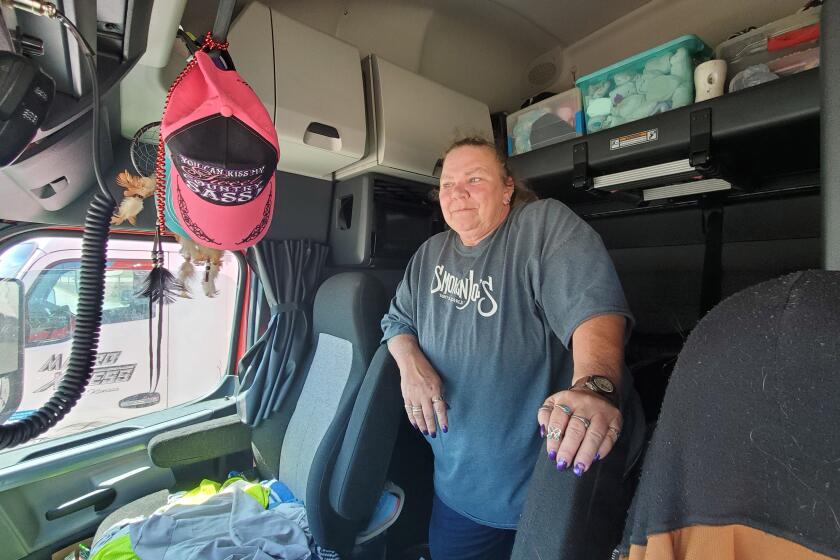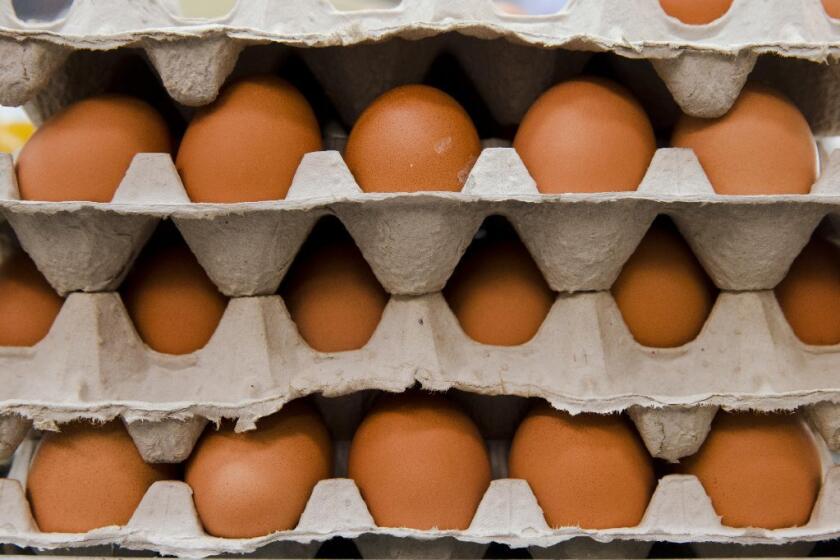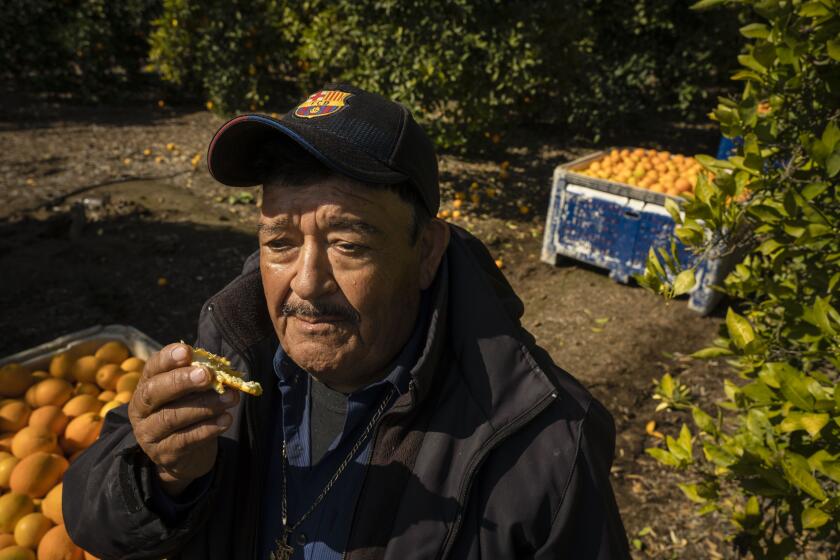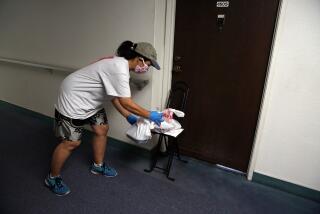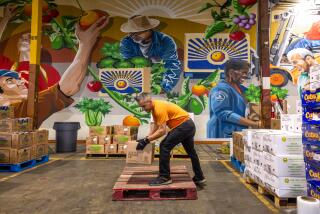Rotting food. Hungry masses. Chaotic supply chains. Coronavirus upends the U.S. food system
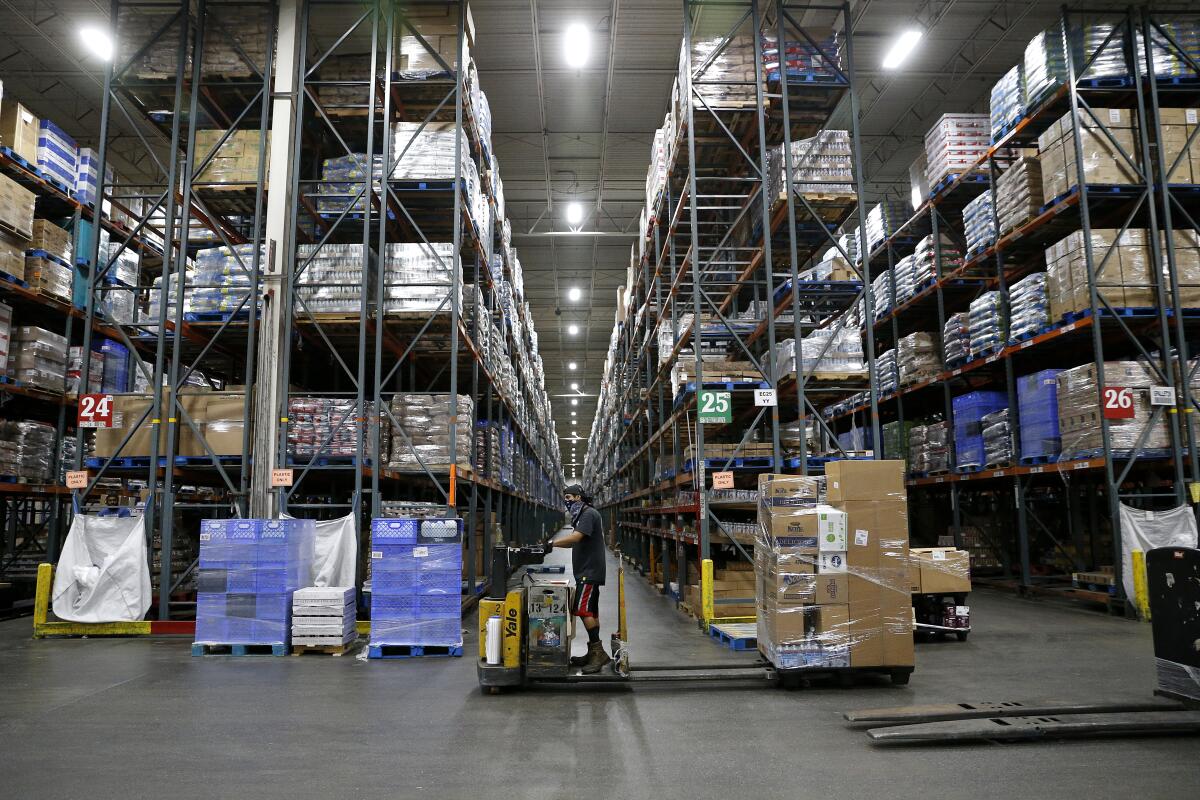
- Share via
Near downtown Los Angeles, a meat processing plant ramped up production even as it worked to keep frontline employees separated from one another. In Salinas, Calif., a lettuce grower hustled to redirect supply after being forced to plow under unused crops.
In the Bay Area, a food distributor that previously served restaurants started selling produce boxes directly to consumers. Near the Mexico border, a food bank expanded distribution to meet an explosion of need. And in Hollywood, a nonprofit that has served sit-down meals to homeless people for 33 years shifted to takeout.
“We’ve completely had to change what we’re doing,” said Sherry Bonanno, executive director of the Hollywood Food Coalition. “We just keep adapting and adjusting.”
In less time than it takes a farmer to plant and harvest a head of lettuce, the nation’s entire food industry has been flipped on its head by the COVID-19 pandemic. An intricate system for matching supply with demand, established over decades, has been thrown out of whack just as unemployment and food insecurity are skyrocketing among families.
The fallout has been particularly severe in California, where more than a third of the country’s vegetables and two-thirds of its fruits and nuts are grown — and where hunger and homelessness were already deeply entrenched.
Toward a more sustainable California
Get Boiling Point, our new newsletter exploring climate change, energy and the environment.
You may occasionally receive promotional content from the Los Angeles Times.
In response, a vast network of food producers, distributors, retailers and advocates have been scrambling to find a new equilibrium, to shore up the nation’s food supply and their own bottom lines while reducing waste and want.
In dozens of interviews, farmers, truckers, grocery executives, restaurateurs, food service providers and food bank administrators from Northern California to the Imperial Valley said the effort has been exhausting, but worth it.
The farmers
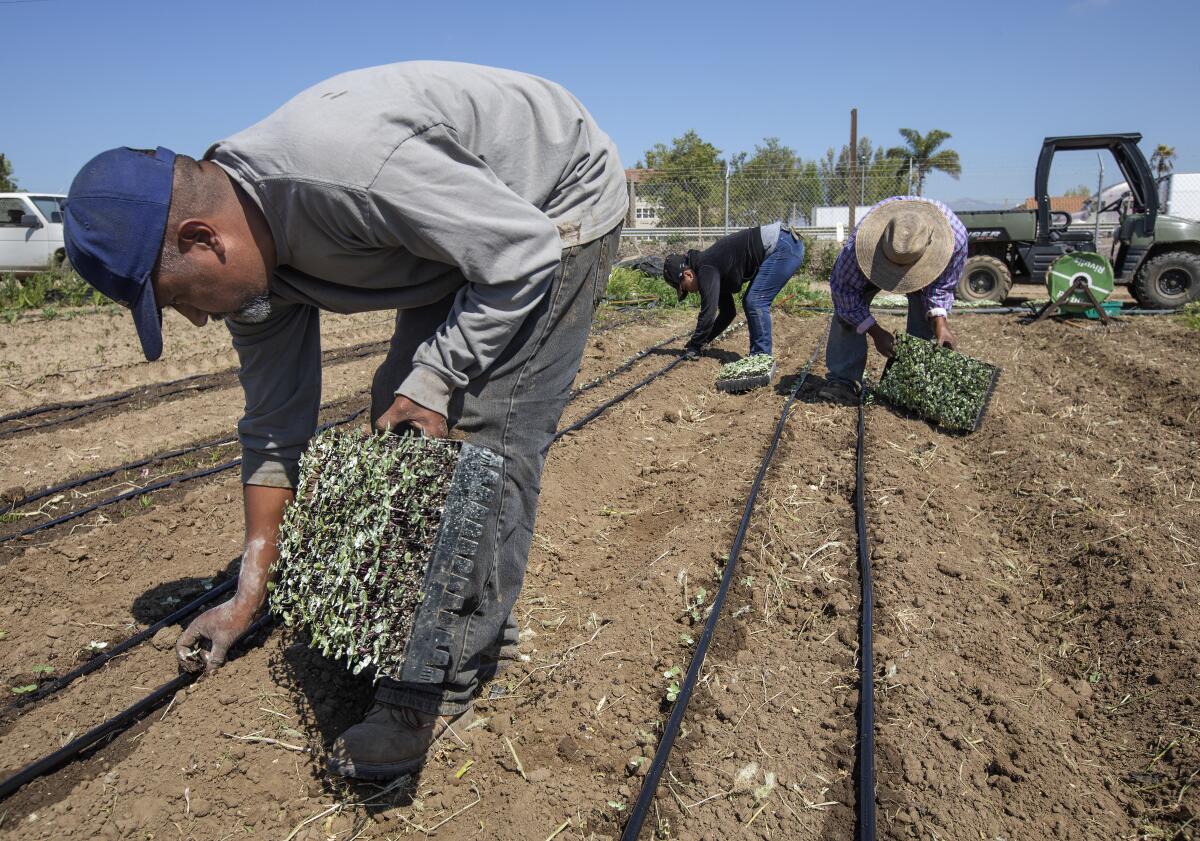
It all went haywire March 16, when Gov. Gavin Newsom asked restaurants to close their doors. The food service industry, which supplies restaurants and bars, as well as schools, hotels, production studios and catering services, immediately tanked. As nervous shoppers flocked to grocery stores to stockpile food, retail demand shot up, but not enough to make up for all the lost demand from restaurants.
“It was just a crazy swing,” said Scott Grabau, president and chief executive of Tanimura & Antle, a Salinas-based lettuce producer.
Crops planted months before based on pre-pandemic demand spoiled without buyers. Billions of dollars’ worth of produce went to waste, much of it tilled back into the soil, said Cathy Burns, CEO of the Produce Marketing Assn., which represents produce companies.
Grabau’s company, which grows year-round in California and Arizona, stopped harvesting entire fields. He’s thinking about planting more iceberg and romaine, which grocery shoppers buy, and less of the boutique leaves used by chefs.
Grabau’s team has had to be more agile than ever, packaging produce to fit orders that customers keep changing on the fly. He’s constantly in communication with his employees in the field.
“It’s a walkie-talkie call that says, ‘Hey, stop doing this. This order increased, so start doing this instead,’” Grabau said.
The meat processors
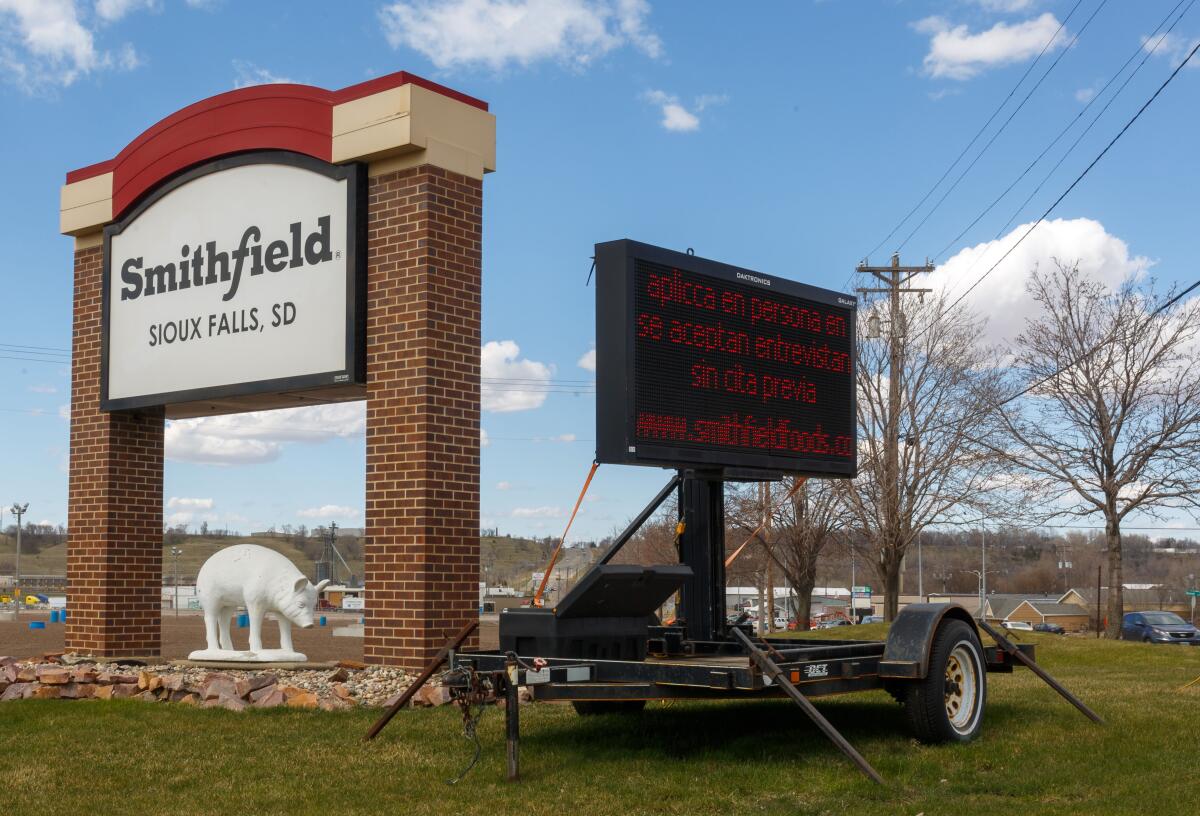
Few parts of the supply chain have been hit as hard as meat processing. Dozens of plants have been shuttered due to coronavirus outbreaks, prompting President Trump last week to order facilities to stay open as a matter of national security. Unions and others have objected, pointing to thousands of infections among meat workers.
Zack Levenson is chief operating officer for Golden West Food Group, based in Vernon, which produces beef, pork and chicken products.
The company, which has not had a known coronavirus infection in any of its facilities, slowed production for a couple of weeks to protect employees but has since maneuvered to expand capacity by millions of pounds of meat per week, Levenson said.
By good fortune, the company just weeks before the pandemic had commissioned the conversion of old dry-packing space in its main facility into more raw-meat processing space. That proved crucial for ramping up production at a time when employees had to be spaced farther apart, Levenson said.
For worker safety, the company began instituting special protocols early on, Levenson said. Masks were introduced, “hand sanitizer is everywhere,” new plastic dividers have been installed, and teams have been isolated, he said.
That way, if a line member gets ill, the company is able to quarantine his or her 10-member team without halting the entire operation.The truckers
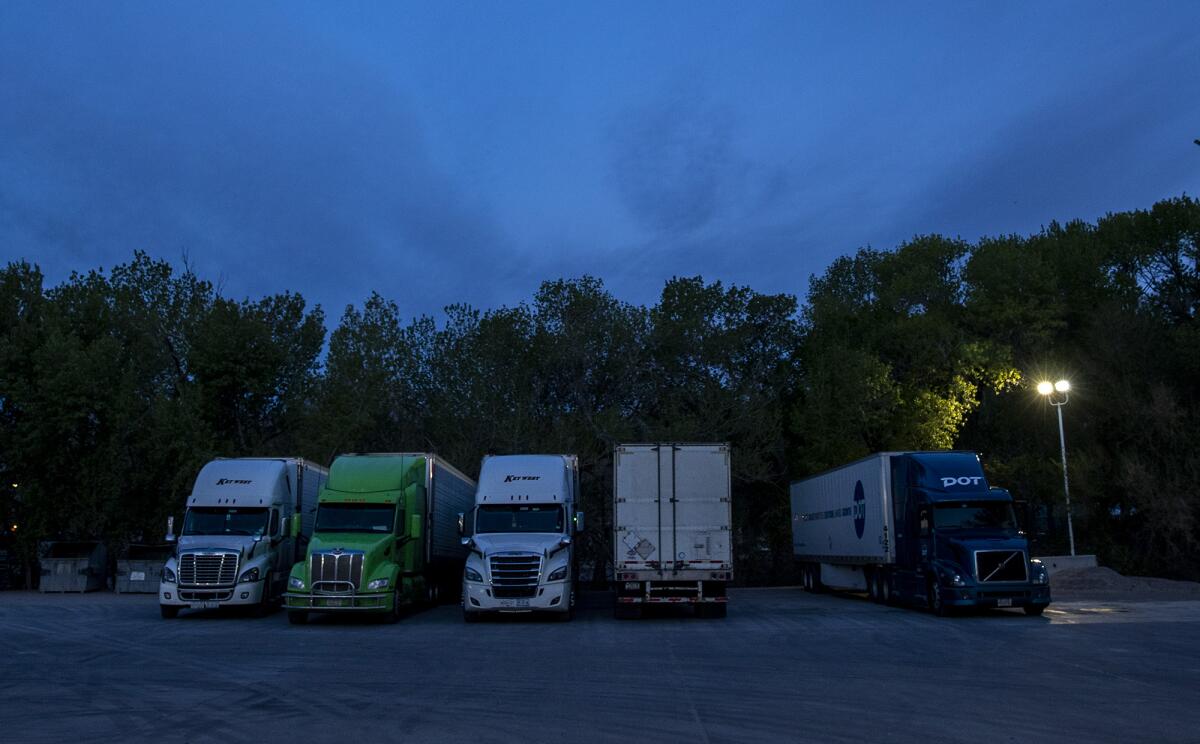
Zach England, chief operating officer of C.R. England, a Utah-based company that hauls produce and meat in refrigerated trucks across California and other states, said the pandemic has created a seesaw effect.
About 4,000 of his company’s 6,000 or so drivers regularly haul food. Demand for their services shot up in the early weeks of the pandemic as grocers struggled to stock shelves, but that has since leveled off.
The pandemic turned some truckers into essential workers hauling high-value loads that put them at risk, while others have less work despite the risk
Overall, there are more haulers on the hunt for work and less freight. Smaller trucking outfits are hurting; owner-operators are being paid less. The logistics involved in keeping truckers working, England said, have been intense.
Greg Dubuque, president of the California Trucking Assn. and owner of Liberty Linehaul West in Montebello, said trucking companies are “just trying to keep our wheels rolling to get to a better day.”The distributors
Food service is a $303-billion industry, with 350,000 employees delivering 8.7 billion cases of product across the U.S. annually, according to Mark Allen, president and CEO of the International Foodservice Distributors Assn.
The industry “walked off the cliff” when restaurants and other businesses closed in the middle of March, with most distributors losing 60% to 90% of their volume, Allen said.
Ed Maybrun, owner of Cotati Food Service in Sonoma County, lost about 80% of his business overnight and has been hustling to stay afloat since.
He started storing more food for big customers in his freezers and looking for new inventory to sell. He took on deliveries for a local food bank and started breaking apart industrial-size packages of bread, paper products and other staples to sell directly to consumers.
“I’ve never worked so much for such a small piece of business in my life,” Maybrun said.
The restaurants

When the restaurants shuttered, a shock wave rippled out from owners and managers to servers, bartenders, dishwashers and cooks. It wasn’t pretty.
“We went straight into panic mode,” said Curtis Stone, the Australian chef who has cooked for the likes of Oprah Winfrey and has two high-end restaurants in the Los Angeles area: Maude and Gwen.
“We were like, ‘Oh my God, how do we just stay in business and make sure everyone gets their next paycheck?’” Stone said.
At first, there was no way. He simply couldn’t afford to keep on more than a dozen or so staff.
But that has since changed.
At Gwen, which always functioned in part as a butchery, Stone and his managers turned the restaurant into a sort of neighborhood market. They started doing a modest trade on eggs and milk, boxes of produce and prime cuts of meat.
They joined food delivery apps to connect with more customers. They created a new menu of comfort food for takeout. And they started replicating the process at Maude, which previously had been an exclusive 24-seat, three-course dining experience.
As the new model began to catch hold, Stone found he was able to start bringing staffers back.
“We made a decision early on as a team to not stand around and talk about how bad it is,” he said. “We just don’t have the time to be unproductive.”
The grocers

In the first weeks of the shutdown, customers cleared grocery shelves faster than they could be restocked, even though inventory was streaming in from suppliers. Shoppers were buying four to eight weeks worth of food at once.
There weren’t enough trucks to handle the demand, said Nancy Lebold, vice president of merchandising for Food 4 Less, a value grocer with a large customer base in the Latino community. At times, big orders just wouldn’t show up.
Normally, fruit accounts for 60% of produce sales, and vegetables the remainder. The first week of the shutdown, they flip-flopped, Lebold said, and have stayed that way ever since.
Other patterns of food consumption also were upended as people became reacquainted with their kitchens, and some automated supply processes were slow to respond, said Manny Vivanco, regional logistics director for the Kroger Co., which owns Ralphs and Food 4 Less.
Food 4 Less operates three inventory warehouses in the Los Angeles region: one in Paramount that is 98% automated, one in Compton that is about half-automated and one in Riverside that is not automated, relying instead on frontline associates.
As shoppers rushed to grocery stores to stock up on food staples, they cleaned out egg aisles across the country. That has boosted egg prices.
As demand surged, the automated warehouses couldn’t keep up, Vivanco said. Meanwhile, workers in Riverside were cranking out increased orders.
In recent weeks, Kroger and other grocers have been trying to keep stores stocked even as dozens of workers have become ill, and unions have protested what they say are management failures to protect them.The food banks

The COVID-19 chaos severely diminished the supply of free food to food banks, just as need surged.
Millions of Californians have lost work due to the pandemic. Many have been left hungry.
In the first three weeks of April, nearly 265,000 people applied for government food assistance under the CalFresh program — more than double the number who applied during the same period last year — according to the California Department of Social Services, which administers the program.
The number of people arriving at the Food Bank of Contra Costa and Solano has doubled, said Cassidie Bates, the organization’s policy and advocacy manager.
“We have seen a completely new population emerge,” Bates said.
Meanwhile, grocery stores are selling more of their stock and passing on less food. Restaurants and other businesses that closed had lots of inventory to hand off to food banks in the first days of the shutdown, but that supply has run dry. And what was pulled in at the start of the pandemic has largely gone out the door already.
Food banks normally stockpile at this time of year, but demand is too high to hold back anything, Bates said.
The Imperial Valley Food Bank near the southern border, which normally serves 20,000 people each month, served more than 26,000 in the first three weeks of April, said Sara Griffen, the executive director.
Many of the food bank’s clients are farmworkers who have lost hours, a particularly cruel irony.
California’s 420,000 farmworkers are working through the crisis. But language barriers and a lack of communication on the coronavirus put many at risk.
Griffen said local farmers have provided produce, but she still worries about protein, having recently received word that “quite a few” of her expected meat shipments had been canceled, likely due to closures of meat processing plants, she said.The advocates
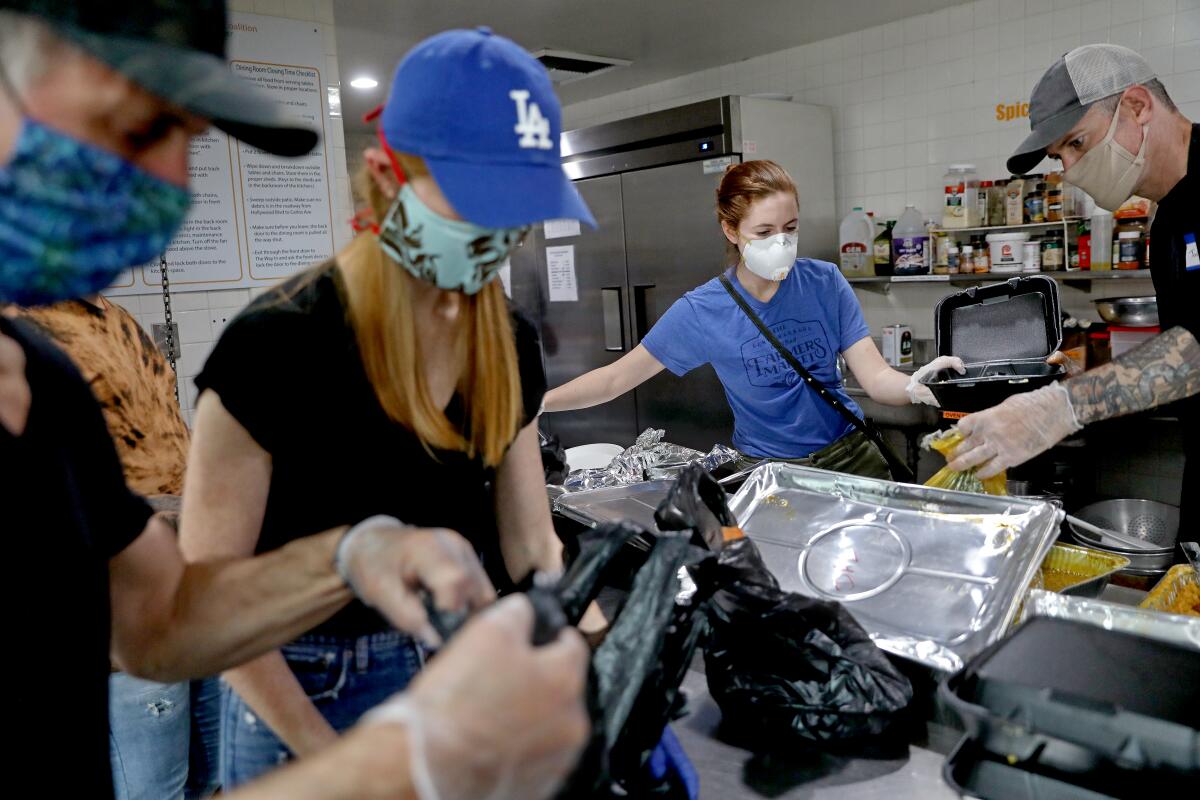
On a recent afternoon, Bonanno of the Hollywood Food Coalition was moving a mile a minute. She’s always busy, but more so with the move to a new model where clients no longer stream inside for warm meals but get handed their food outside.
“Everything is in a to-go bag,” she said.
On top of that, Bonanno said, her normal supply chains have collapsed.
Her group has long received food from the movie studios. A single day of production on a film or television set could yield enough leftover meals for hundreds of people on any given night. Now, all the studios have closed. Caterers, restaurants and groceries are providing less, too.
“Normally there’s tons of overproduction of food, and lots of different organizations will try to scramble to take that,” she said. “What’s been disrupted is the regular restaurant, caterers and grocery-store distribution system.”
Rick Nahmias, executive director of Food Forward, a nonprofit that collects food for redistribution, said his organization has been ramping up efforts in the face of huge need.
He started the group a decade ago, harvesting unused fruit from a single tree in his backyard. It grew to handling 2 million pounds of food per month. Amid the pandemic, it’s handling 800,000 pounds a week, scrambling to redirect excess farm produce to places like the Hollywood Food Coalition.
At distribution points where food is given directly to hungry Californians, “food that would last for three hours just a few months ago is now gone in five, 10, 15 minutes,” Nahmias said.
The future
Across the nation’s food web, people are nervous and frustrated. There is great need, but there is also hope for a future with less waste and more humanity.
“The whole world is trying to figure out how to rebalance the supply and demand,” said Chris Tang, a supply chain expert and professor at the UCLA Anderson School of Management. “We have so much food being wasted. The question is, how do you reduce the food waste so that the food will actually get to the people in need?”
Already, new lines of communication are opening between producers and those on the front lines of poverty and hunger. Tang hopes that government and the private sector will do even more to link the two. California, with its tech hubs and massive farms, could take the lead.
He sees a new, nationwide online platform where those with food can immediately be paired up with those who need it.
“Given that we are facing some of our darkest hours,” Tang said, “this is one bright spot.”
More to Read
Sign up for Essential California
The most important California stories and recommendations in your inbox every morning.
You may occasionally receive promotional content from the Los Angeles Times.
